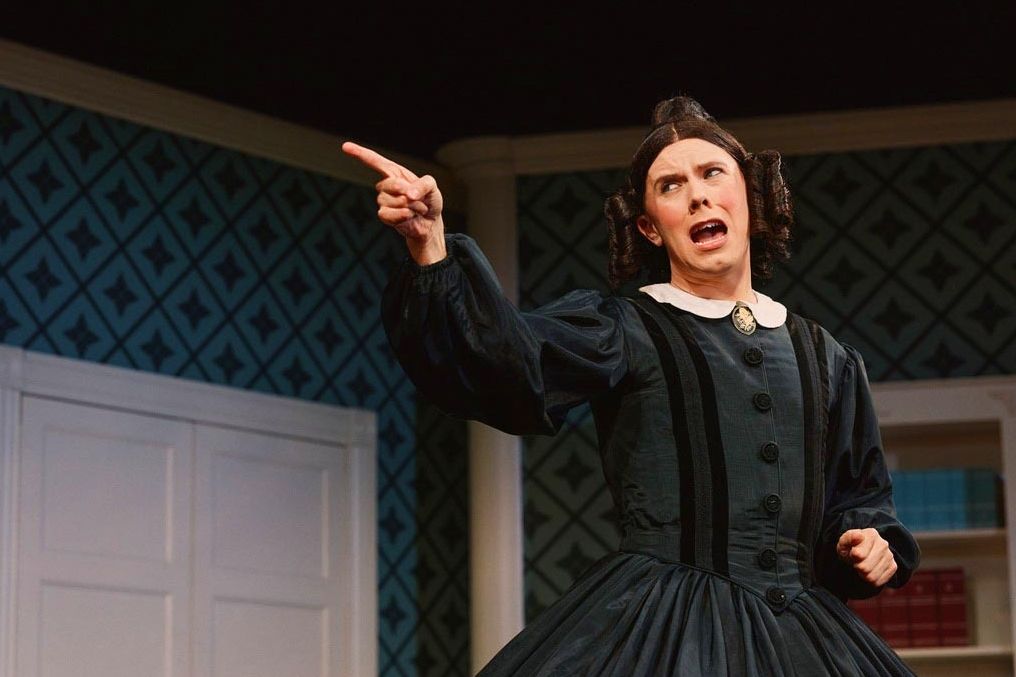Review: Mary Poppins
BROADWAY BUFFS, TAKE CHEER!
Broadway’s Mary Poppins has an awful lot to offer audiences. It’s a visual stunner and a song-and-dance sensation, and Stephanie Lee does a flawless incarnation of Julie Andrews’ Mary. Culturephile’s child consultant, 7-year-old Lily, was appropriately wowed. Below are a few touches that left a big beautiful impression.
GENERAL STAGE MAGIC
Breathtaking backdrops
The sets in Mary Poppins are nothing short of resplendent, dazzling, disorienting—and their impact can hardly be overstated. They’re like a Rose Parade float wrapped in a ribbon of starlight. They’re like a cathedral cupola that rains soot clouds and flowers. Their forced-perspective designs will pull you in like a magnet, and tilt your head helplessly skyward like an alien abductee. These sets are so stunningly stimulating, the action could almost be an afterthought.
Mary flying
In the first scene, there’s a fakeout: A tiny, tacky light is swept across the stage to symbolize Mary’s flight. But don’t worry: before the production’s over, Ms. Poppins flies on actual wires at least twice, and completely sells the maneuver as flight.
Bert dancing on the ceiling
Now, this is a piece of stage-craft that borders on witchcraft. I still don’t really know how they did it: At the height of the chimney-sweep dance-a-thon “Step In Time,” Bert takes a tippety-tappety stroll—up the right side of the proscenium arch, and then strides upside down into the center of it. Dangling heels-over-head like a bat, he does a sprightly little tap dance. Kids are inevitably amused, but adults who appreciate logistics and design will quietly mutter, “How the…/ What the….?”
The reverse-gravity banister
Like the above example, this stage moment is meant to show the character’s magical powers, but is an equal testament to the set designer’s. While simply leaning on a banister, Mary is swept to the top of the staircase, spit-spot.
The giant umbrella
Three quarters of the way through the production, heads up for a slowly rotating, glowing violet umbrella the size of the sky. Don’t question it; just surrender to the mother ship.
PARTICULAR CHILD PLEASERS
A child-centric story
With their expressive voices and pantomime, Jane and Michael Banks stand in the spot where every boy or girl would like to be: under the all-encompassing umbrella of a magical nanny. Audience kids live vicariously through these two, making the magical moments feel more “real.”
Animals and statues springing to life
Our Child Consultant Lily was instantly enamored by the talking, dancing statuary that replace animated penguins in the “Jolly Holiday” scene. With sculpted, marbled bodysuits and tastefully-placed fig leaves, they convincingly resemble “real” statues. Meanwhile, a well-groomed little gray dog in pigtails (which, in fantasy scenes, morphs into technicolor—pink? green?) seems so lifelike, it feels rude to assume that he’s a puppet. Let’s just pretend he’s real.
Brightly colored, cartoonish costumes
Poppins, the children, and the mother are outfitted to a tee, with Mary’s color pallet seemingly punched up a little for the stage. The people who sing “Supercalifragilisticexpealidocious” are cartoonishly clad, mirroring their actual cartoon counterparts in the movie. Bobbing tassels, springy bustles, and buoyant hair are everywhere, and Lily liked it.
Chimney-sweep chaos
It’s fun to jump on the bed. It’s fun to dirty the floor and break the furniture. It’s dangerous, it makes adults angry, and the fun is fleeting—but it’s fun. This feeling is nicely evoked by the filthy-dirty chimney sweeps, who invade the Banks’ stately home for a raucous romp during “Step In Time.” Like it or not, children revel in consequence-free anarchy, so the chimney sweeps swoop in for an easy win.
Realistic kite-flying
Making good on the sung suggestion to “go fly a kite and send it soaring,” the banks children fly a kite in the park, alongside a flock of others on wires thin enough to suspend disbelief. This is one of the only activities in the play that young kids can actually go home and imitate, which makes it charming.
Warning: only avid Poppins people, theatrical sticklers and philosophy wonks, should read beyond this point. All others, go get your tickets.
________________________________________________
Still here? Very well. Don’t say we didn’t warn you:
POPPINS PURISTS, BEWARE!
We hate to invoke “ain’t broke, don’t fix,” but it really applies here. At the inception of this Broadway adaptation, the 1964 film Mary Poppins had already flourished for 40-some years—a testament that it was not only " not broke," but “practically perfect in every way.” However, where recent local productions like PCS’s A Christmas Story have seamlessly transferred film content to the stage, this piece deviates from its film in some significant ways. Card-carrying, song-singing Poppins-heads who use the film as their baseline, should brace themselves for a few shocks:
Non-original songs
Trotting out new numbers and throwing out original film songs, this Mary Poppins has changed her tune…significantly. Most of George Banks’ self-righteous vocab-building rants (“The Life I Lead” and “Fidelity Fiduciary Bank”) are folded into a dumbed-down amalgamation called “Precision.” Meanwhile, the brilliant reverse-psychology lullabye “Stay Awake” is put to bed completely, and “Fly A Kite’s” waltz companion “I Love To Laugh” is also stifled. “Sister Suffragette” ‘s battle cry is nixed for a victimish new swan-song called “Being Mrs. Banks.” Meanwhile, reward-promoting “Spoonful of Sugar” is offset by a punishment-pushing new dirge, “Brimstone and Treacle.” Why, Disney? Problems at the licensing office? Input from a challenge-averse focus group? If this is an attempted “improvement” on the original songbook, it’s an inevitable failure.
The addition of a “witch”
You tell us: Is it okay that Mary Poppins now battles a rival nanny (played expertly by Q. Smith), and prevails by locking the evil Black character into a giant cage and making her disappear? We want to understand that the character of Miss Andrew is exhumed from the 1934 original book series, and literary buffs might find merit in this “back to the source” approach. We also want to credit the casting choice to Smith’s powerful talent. Nevertheless, the scene feels out of character for the Mary we know, and downright inflammatory in its antique British setting with undertones of classism and empire. Perhaps Maya Angelou would like to weigh in on why this caged bird sings?
Bert’s inconsistent accent
Billy Elliot spoiled us. After hearing its pitch-perfect Northern UK accents last month, we assumed that modern Broadway had dialect on lock. Imagine our dismay upon hearing Bert (Nicholas Dromard), the play’s narrator and male lead, flipflop between cockney, posh, Irish and American with each new quip and note. (Picky? Perhaps. Pervasive? Completely. As they’d say in England, “Get it sorted.”) To be fair, the guy has a lot of other business to attend to, and he’s generally charming and coordinated in his role.
Vengeful toys
In this version, the toys come to life (a la Portland Opera’s recent L’Enfent) to chastise the children. We’re told that they’re mad about being thrown around, and they’re not going to take it anymore—nevertheless, the scene goes largely unresolved. The toys, several of which are stuffed muslin monstrosities that don’t closely resemble animals or dolls, just bob around looking bizarre and creepy.
A significant shift in tone and hue
The Poppins film’s enduring popularity hangs on a couple perennial themes: Parents shouldn’t allow their adulthood to be a barrier to bonding with their children. (Mr. Banks, go fly a kite.) Middle-class bourgeois kids become more well-rounded when they get out of the house and interact with all types of people (in this case, chimney sweeps, street painters and bird-feeding bag-ladies). Adventure is easily accessed through imagination and the power of words (“supercalifragi…,” and others), and mundane tasks are easily sweetened by a good attitude (the symbolic “spoonful of sugar.”) This Cameron Mackintosh adaptation, however, weighs so heavily on pop-psych themes of family dysfunction and nature vs. nurture, that the New York Times referred to Mary as “The Meddler on The Roof” and compared her to Dr. Phil.
George Banks, we’re repeatedly told, is a grumpypants because he was raised too sternly. His broken spirit is only avenged when Mary locks his old nanny in a cage (never mind how she was raised). Mrs. Banks, meanwhile, is a tragically underappreciated trophy-wife, and her blame and shame also roll downhill onto the kids. Sure, these problems are neatly resolved by curtain, but not merely through Mary’s coy cajoling and good example—only with the help of a couple hellfire-and-brimstone (ahem, black-and-white) showdowns. Victims must be vindicated seems to trump Let’s all find ways to get along.
Poppins purists, draw deep from your well of Julie-Andrews-inspired polite forbearance, to indulge this production’s shortcomings. Do it for the children. But then sit them down in front of the ’64 original four or five times. A few spoonfuls of the old sugar should help the new melodrama go down.
For more about Portland arts events, visit PoMo’s Arts & Entertainment Calendar, stream content with an RSS feed, or sign up for our weekly On The Town Newsletter!




